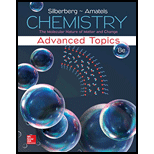
Concept explainers
(a)
Interpretation:
The given reaction is an addition, elimination or substitution reaction has to be stated.

Concept Introduction:
The addition, elimination and substitution reactions are types of organic reactions which can be identified by the number of bonds to carbon in reactants and products.
Addition reaction:
When an unsaturated reactant becomes a saturated product, the reaction is said to be addition reaction.

Elimination reaction:
When a saturated reactant becomes an unsaturated product, the reaction is said to be elimination reaction.

Addition and elimination reactions are opposite to each other.
Substitution reaction:
When a group or an atom in the reactant is substituted by a group or an atom from the other reactant, the reaction is said to be substitution reaction. In substitution reaction, the substitution occurs on the carbon from which a group or an atom is removed.

(b)
Interpretation:
The given reaction is an addition, elimination or substitution reaction has to be stated.

Concept Introduction:
The addition, elimination and substitution reactions are types of organic reactions which can be identified by the number of bonds to carbon in reactants and products.
Addition reaction:
When an unsaturated reactant becomes a saturated product, the reaction is said to be addition reaction.

Elimination reaction:
When a saturated reactant becomes an unsaturated product, the reaction is said to be elimination reaction.

Addition and elimination reactions are opposite to each other.
Substitution reaction:
When a group or an atom in the reactant is substituted by a group or an atom from the other reactant, the reaction is said to be substitution reaction. In substitution reaction, the substitution occurs on the carbon from which a group or an atom is removed.

(c)
Interpretation:
The given reaction is an addition, elimination or substitution reaction has to be stated.

Concept Introduction:
The addition, elimination and substitution reactions are types of organic reactions which can be identified by the number of bonds to carbon in reactants and products.
Addition reaction:
When an unsaturated reactant becomes a saturated product, the reaction is said to be addition reaction.

Elimination reaction:
When a saturated reactant becomes an unsaturated product, the reaction is said to be elimination reaction.

Addition and elimination reactions are opposite to each other.
Substitution reaction:
When a group or an atom in the reactant is substituted by a group or an atom from the other reactant, the reaction is said to be substitution reaction. In substitution reaction, the substitution occurs on the carbon from which a group or an atom is removed.

Want to see the full answer?
Check out a sample textbook solution
Chapter 15 Solutions
Student Solutions Manual For Silberberg Chemistry: The Molecular Nature Of Matter And Change With Advanced Topics
- Complete and balance the following half-reaction in acidic solution. Be sure to include the proper phases for all species within the reaction. S₂O₃²⁻(aq) → S₄O₆²⁻(aq)arrow_forwardQ Select to Edit NH3 (CH3)2CHCI (1 equiv) AICI 3 Select to Draw cat. H2SO4 SO3 (1 equiv) HO SOCl2 pyridine Select to Edit >arrow_forwardComplete and balance the following half-reaction in basic solution. Be sure to include the proper phases for all species within the reaction. Zn(s) → Zn(OH)₄²⁻(aq)arrow_forward
- b. ὋΗ CH3CH2OH H2SO4arrow_forwardFor the reaction A (g) → 3 B (g), Kp = 0.379 at 298 K. What is the value of ∆G for this reaction at 298 K when the partial pressures of A and B are 5.70 atm and 0.250 atm?arrow_forward14. Calculate the concentrations of Ag+, Ag(S2O3), and Ag(S2O3)23- in a solution prepared by mixing 150.0 mL of 1.00×10-3 M AgNO3 with 200.0 mL of 5.00 M Na2S2O3 Ag+ + S20 Ag(S203)¯ K₁ = 7.4 × 108 Ag(S203)¯ + S20¯ = Ag(S203) K₂ = 3.9 x 104arrow_forward
- ΗΝ, cyclohexanone pH 4-5 Draw Enamine I I CH3CH2Br THF, reflux H3O+ I Drawing Draw Iminium Ionarrow_forward:0: :0: Select to Add Arrows :0: (CH3)2NH :0: ■ Select to Add Arrows :0: :0: (CH3)2NH ■ Select to Add Arrowsarrow_forwardDraw the product of the following H action sequence. Ignore any inorganic byproducts formed. 1. (CH3CH2)2CuLi, THF 2. CH3Br Q Atoms, Bonds and Rings H Charges ㅁarrow_forward
- Please help me with this the problem is so confusingarrow_forward14 Question (1 point) Disiamylborane adds to a triple bond to give an alkenylborane. Upon oxidation with OH, H2O2, the alkenylborane will form an enol that tautomerizes to an aldehyde. In the first box below, draw the mechanism arrows for the reaction of disiamylborane with the alkyne, and in the last box draw the structure of the aldehyde. 4th attempt Feedback i > 3rd attempt OH, H2O2 i See Periodic Table See Hintarrow_forwardanswer with mechanisms and steps. handwritten please!arrow_forward
 ChemistryChemistryISBN:9781305957404Author:Steven S. Zumdahl, Susan A. Zumdahl, Donald J. DeCostePublisher:Cengage Learning
ChemistryChemistryISBN:9781305957404Author:Steven S. Zumdahl, Susan A. Zumdahl, Donald J. DeCostePublisher:Cengage Learning ChemistryChemistryISBN:9781259911156Author:Raymond Chang Dr., Jason Overby ProfessorPublisher:McGraw-Hill Education
ChemistryChemistryISBN:9781259911156Author:Raymond Chang Dr., Jason Overby ProfessorPublisher:McGraw-Hill Education Principles of Instrumental AnalysisChemistryISBN:9781305577213Author:Douglas A. Skoog, F. James Holler, Stanley R. CrouchPublisher:Cengage Learning
Principles of Instrumental AnalysisChemistryISBN:9781305577213Author:Douglas A. Skoog, F. James Holler, Stanley R. CrouchPublisher:Cengage Learning Organic ChemistryChemistryISBN:9780078021558Author:Janice Gorzynski Smith Dr.Publisher:McGraw-Hill Education
Organic ChemistryChemistryISBN:9780078021558Author:Janice Gorzynski Smith Dr.Publisher:McGraw-Hill Education Chemistry: Principles and ReactionsChemistryISBN:9781305079373Author:William L. Masterton, Cecile N. HurleyPublisher:Cengage Learning
Chemistry: Principles and ReactionsChemistryISBN:9781305079373Author:William L. Masterton, Cecile N. HurleyPublisher:Cengage Learning Elementary Principles of Chemical Processes, Bind...ChemistryISBN:9781118431221Author:Richard M. Felder, Ronald W. Rousseau, Lisa G. BullardPublisher:WILEY
Elementary Principles of Chemical Processes, Bind...ChemistryISBN:9781118431221Author:Richard M. Felder, Ronald W. Rousseau, Lisa G. BullardPublisher:WILEY





